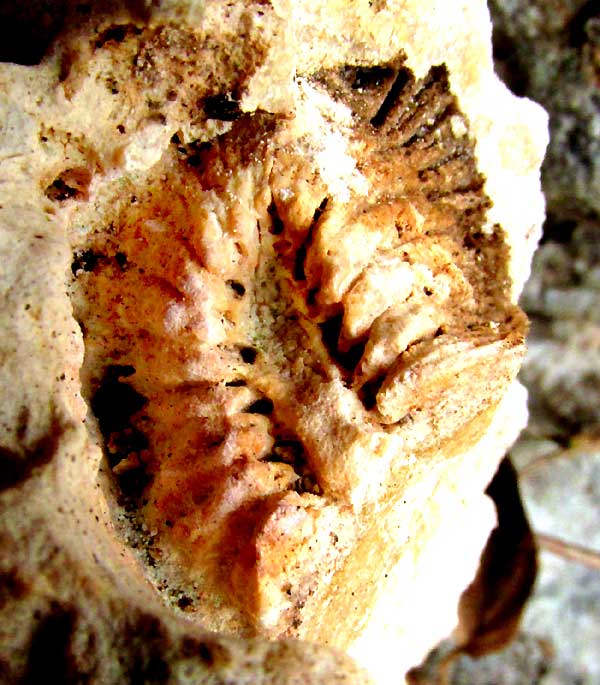Excerpts from Jim Conrad's
Naturalist Newsletter
Issued on April 16, 2020, from the forest just west of Tepakán; elev. ~9m (~30 ft), N21.053°, W89.052°; north-central Yucatán state, MÉXICO
EUSMILIA CORAL

While I was clearing a trail along the ranch's boundary stone wall, a limestone rock became dislodged from the wall, fell onto another rock below, and broke apart, revealing the thumbnail-size fossil shown above. Back at the hut, my little Golden Nature Guide to Fossils, has a page entitled "Mesozoic and Cenozoic Coelenterates" on which an image of a colonial, branching, stony coral showed features like those seen above -- showing vertical-held, waffle-like somethings narrowly attached at their margins to a central, long and narrow something. It was identified as "Eusmilia."
On the Internet, I read that there's only one species of the genus, and that's EUSMILIA FASTIGIATA. However, the page was referring to a living coral occurring on reefs in the Caribbean, commonly known as the Smooth Flower Coral. I'm unsure whether when our our coral was buried at the bottom of the warm Caribbean Sea there might have been other species. Today living Smooth Flower Corals are common to abundant, especially in the south Caribbean.
Our picture provides a view from above the ancient coral, looking down on the cup-shaped tip of a branch of the main coral, a tubular projection called a "corallite." Living coral polyps extended their tentacles from the corallite. The waffle-like things are basically ridges, called septa, providing a rough surface area for the polyps to hold onto. The polyps have grooves at their bases corresponding to the septa ridges. The polyps remain retracted within the corallite during the day, but at night extend their translucent, white tentacles to feed on zooplankton and small invertebrates.
It's not surprising that our fossil has living descendants in the warm Caribbean waters surrounding the Yucatan Peninsula because, geologically, our limestone is very young. Much of the outcropping limestone in northern Yucatan is part of the Carrillo Puerto Formation of Miocene-Pliocene age. The Miocene and Pliocene are often considered as having occurred from 23.8 to 1.8 million years ago. During the few millions of years since then, not much has happened in our geologically stable area to cause many extinctions. The Chicxulub impact which apparently ended the Age of Dinosaurs occurred long before our coral was fossilized, about 65 million years ago.